It kicks off today the second fully online edition of TEFAF, the historic fair for ancient and modern art, which, again for 2021, will unveil exhibitors’ works in virtual booths, viewing rooms, which can be visited by all from September 9 to 13, 2021. The European Fine Art Foundation (TEFAF) is providing a site where you can wander around the virtual stands and see more than 700 works of art and design: you can view high-resolution images, get in touch with gallerists, and learn about the works. We took a tour of the virtual fair, here are the main highlights that we think are worth a look. To participate in the second edition of TEFAF Online simply go to www.tefaf.com, register with your credentials and access the restricted area.
A work that stands out for the very high quality of its execution and composition, suggesting that it is a work by the mature Schedoni, thus dating from a period after he entered the service of Duke Ranuccio in Parma and therefore datable to between 1611 and 1615. It is a very interesting example of Schedoni’s painting and his more mature style, characterized by compositional originality, confidence of execution and a subtle and unusual chiaroscuro play. Embossed on the verso of this painting are burned initials in capitals (CGBC) that document a particularly illustrious provenance, namely the collection gathered in the late 18th and early 19th centuries by the Ferrara Count Giovanni Battista Costabili Conteni. Its earlier history remains unknown since the earliest sources do not seem to mention the table. This is not surprising because it is clearly, as suggested by its small size, an object intended for private use. Another version of this scene was known, identical in composition and also painted on panel. Also worth mentioning from Trinity is an interesting panel painted on both sides (the Justice of Trajan on the front and a Putto playing a drum on the verso), the work of Lippo d’Andrea from about 1428.
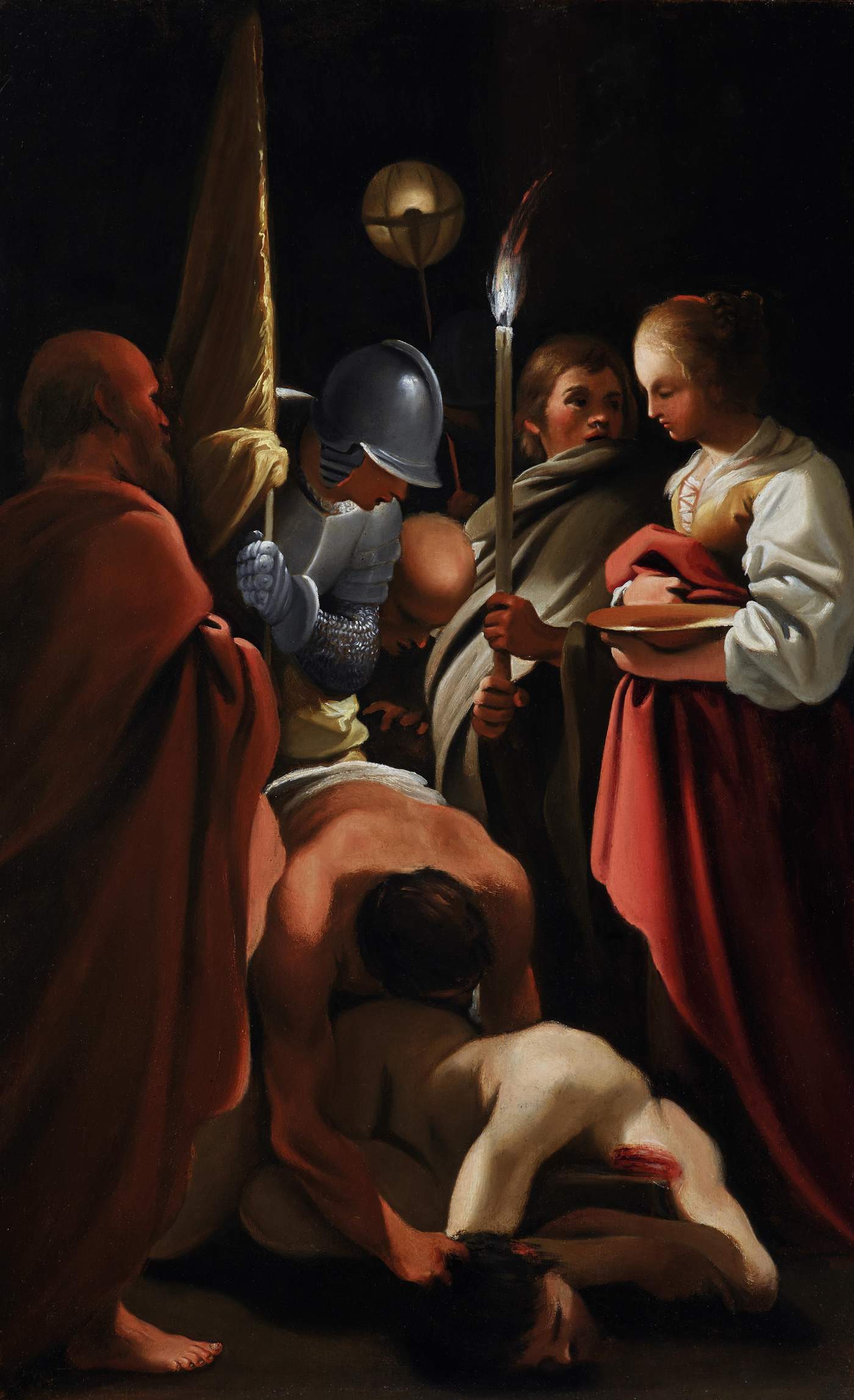
This work stands out among the emblematic half-figures of symbolic and sentimental character in Laurenti’s production. The work is an important novelty because until now it was known only from period photographs and in a second pastel version dedicated to the critic Ugo Ojetti (now in a private collection). The painting was exhibited at the 1895 Venice Biennale and was later published by Mario Morasso in 1902 in a monographic essay in Emporium magazine. The work fully interprets the author’s Symbolist poetics at the time through an iconic figurative and expressive synthesis. The female profile stands out against a stark landscape at dusk, folded in on itself. The figure thus expresses existential unease and desolation; ultimately the condition of modern man. Morasso described it this way, “An elegiac motif, in which sadness becomes despair, in which despair has ravaged and curved the human being; she who was vanquished and orbited bends toward the earth and her hair sinclines heavily, like a dense bundle of tears, like the bundle of misfortunes.”
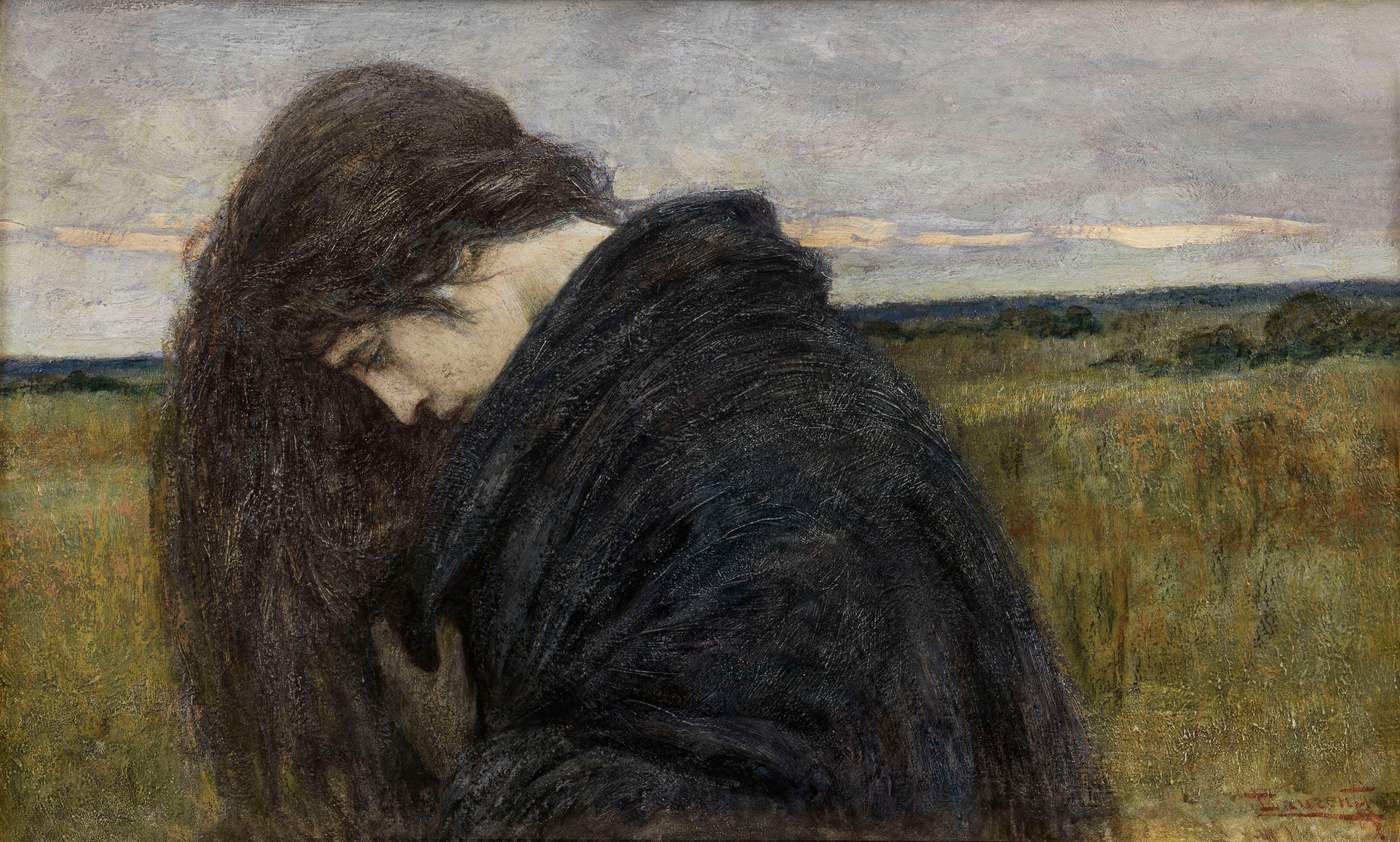
Charles Beddington’s gallery, which specializes in Venetian vedutism, presents this canvas by Francesco Guardi believed to be a key work from the early part of his career. Sold in 1941 as a work by Canaletto, it was recognized as a work by Guardi by Antonio Morassi when it was exhibited in 1966 with another attribution, this time to Michele Marieschi. In his review of the exhibition, Rodolfo Pallucchini stated Morassi’s intention to publish the painting as an early view by Guardi. Morassi later published it in his catalog of paintings by the Guardi brothers and it has since been included in the roster of paintings by the great Venetian artist.
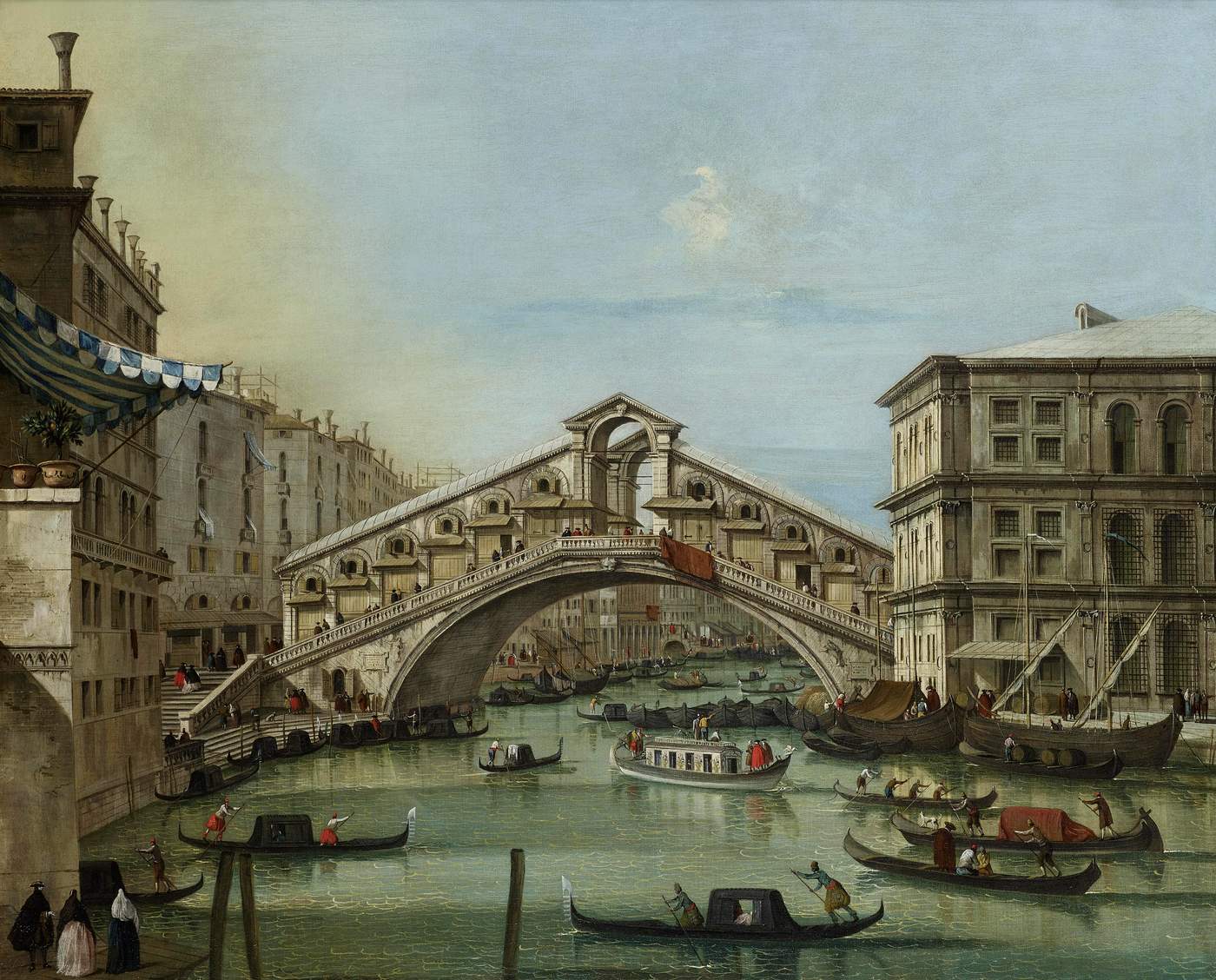
This is a work known since the 1990s, when it passed on the Venetian market and was attributed to Girolamo da Carpi by Alessandro Ballarin, an attribution further confirmed by Mauro Lucco and Alessandra Pattanaro. After two decades, this small painting has only recently resurfaced with an attribution to an anonymous 17th-century Italian artist. In contrast to most works painted in Ferrara of a similar format, which are almost always executed on poplar board, this work is painted on canvas. A recent restoration removed the relatively recent lining and unearthed the very fine original canvas, chosen perhaps precisely because of its greater suitability for transporting the work. The Holy Family stands in the bushes, against the backdrop of some trees, their foliage silhouetted against a leaden sky, illuminated by a flash of pinkish light, which we see reflected on the buildings of a city in the background, sketched in parallel with the tip of a brush. The Virgin and Child are seated, resting on a few stones arranged on the ground as if they were natural bedding, while behind them Joseph rests his head on the back of his hand, his elbow on a large boulder, and is vigilant, as if concerned about the impending threat. Indeed, the few objects arranged in the foreground (an ornate plate, a bag, a canteen) allude to the subject of the Holy Family’s resting during the flight to Egypt, suggested to Joseph by an angel in a dream to save the Child Jesus from the slaughter prepared by Herod.

There is a lot of German expressionism at this edition of TEFAF online, and Beck & Eggling is presenting three works by Emil Nolde (with whom gallery owner Michael Beck’s father, Herbert Beck, had had dealings in person), including this Sommergarten depicting the great artist’s garden. The garden of Emil Nolde and his wife Ada in Seebüll can most likely be considered one of the most important gardens in art history, less well known than Monet’s garden in Giverny but equally important to the artist. In countless paintings and watercolors, Nolde captured all the splendor of form and color that nature offered him over the seasons. From the beginning, paintings of gardens and flowers were a central theme in his work. They are among the first motifs he devoted himself to as an independent artist. This work from 1935 demonstrates this: with vivid brushstrokes, Nolde applied paint to canvas as quickly and spontaneously as possible, a painterly process that eliminates control and rationality as much as possible.
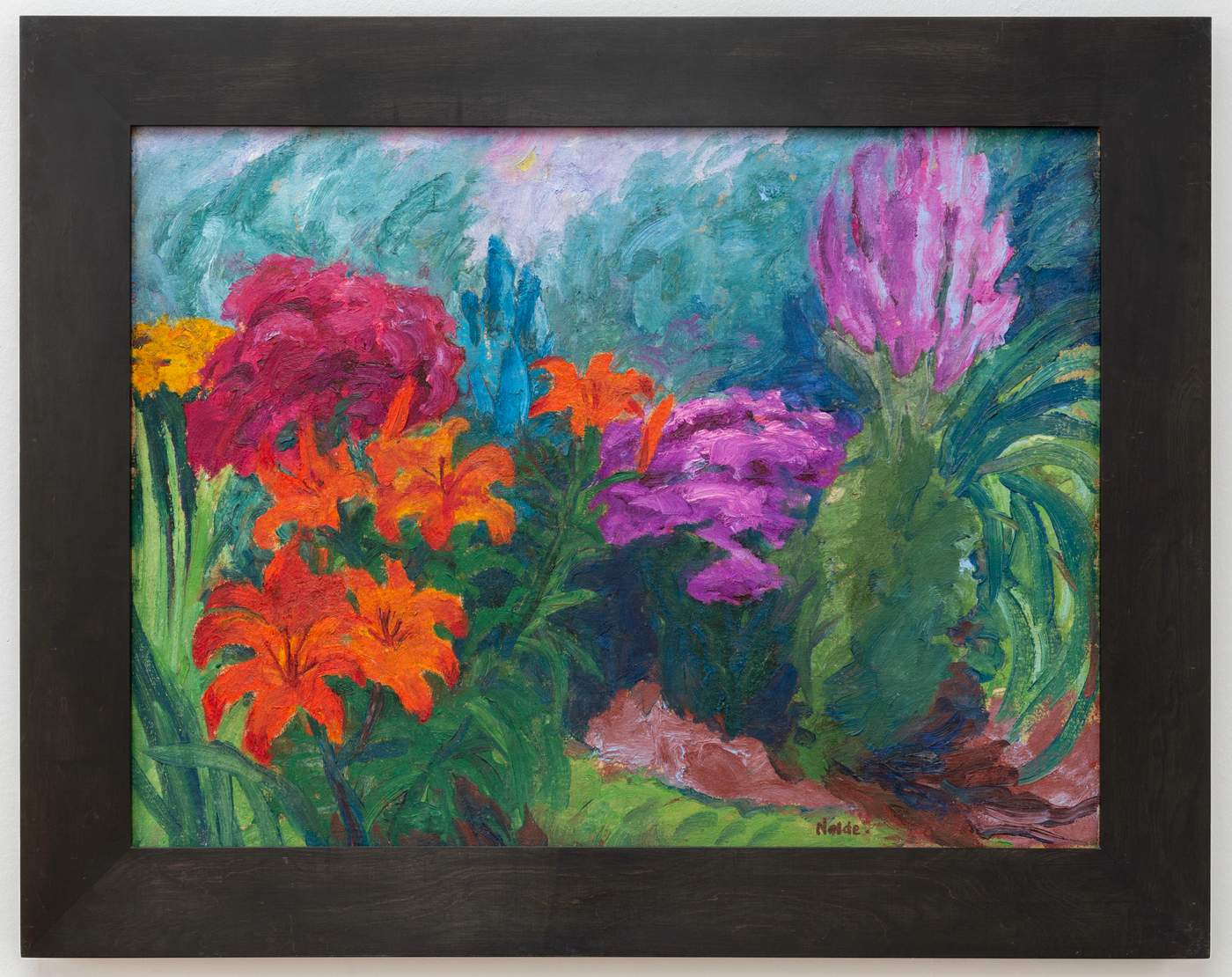
This rare silver miniature fishpond is one of only two known examples of the object. It was made in 1763 by the famous miniature specialist Arnoldus van Geffen. In the second half of the 17th century wealthy ladies, mainly from Amsterdam, had cabinets built as dollhouses, which were then furnished with miniature silver household objects. The dollhouse, like the collector’s cabinet, was intended for display. It was a way to emphasize one’s status. Not everyone could afford a dollhouse, but many wealthy bourgeois of the time had a collection of miniatures. These objects were displayed on wall shelves or in small cabinets. In the first half of the 18th century, the popularity of miniatures in Amsterdam was at its peak-a craze. And the demand for silver miniatures in Amsterdam was so high that generations of silversmiths specialized in making them. Thus many high-quality pieces were made: this is one example.
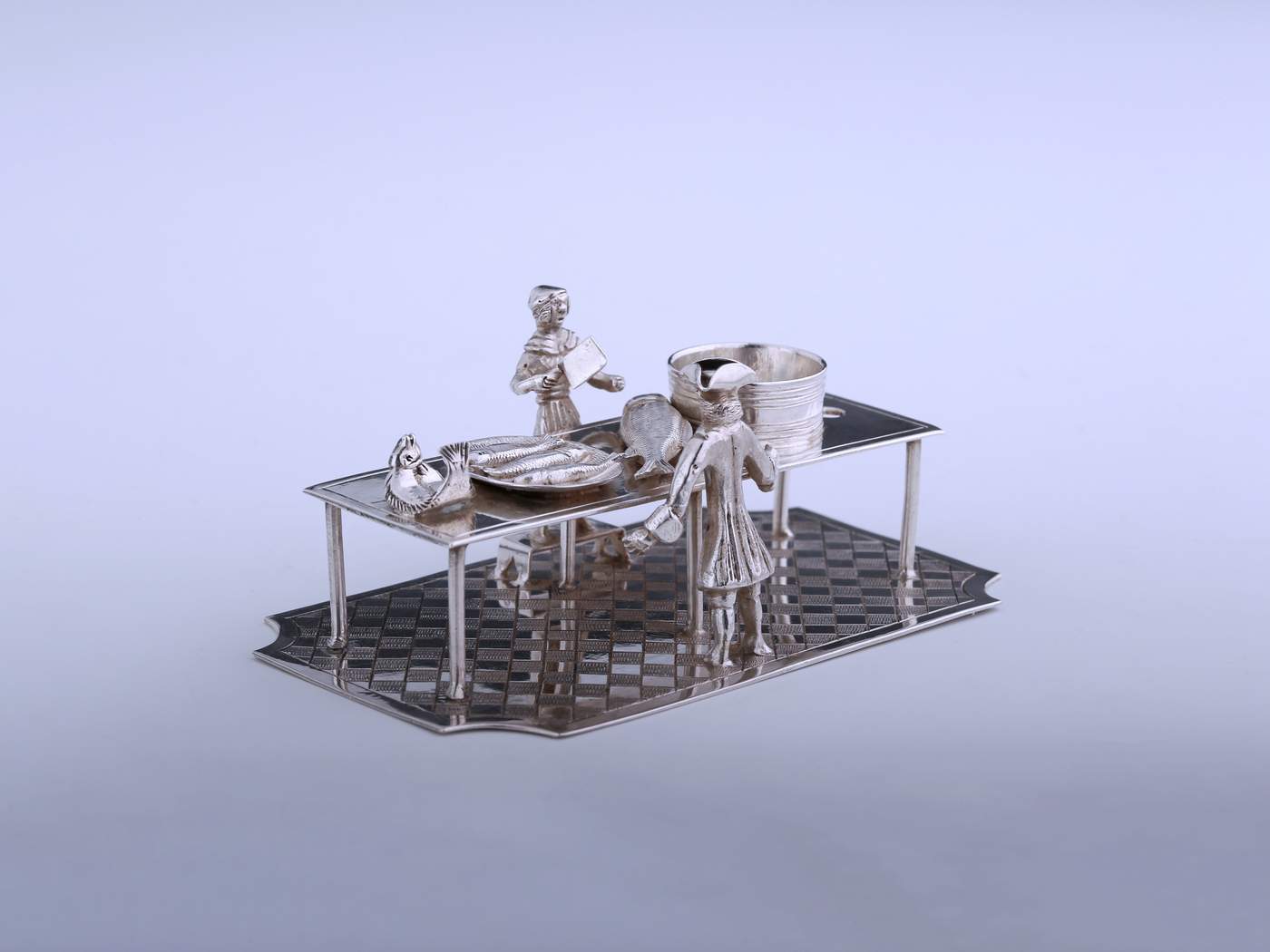
L’Ortolano, who owes his nickname to his father’s work, trained in Ferrara in the orbit of artists such as Domenico Panetti in the first decade of the 16th century. Like his older Ferrara contemporary Boccaccio Boccaccino, he came to express a contemplative ideal that owed much to the world of nearby Venice, which the artist seems to have visited with the young Garofalo; he would go on to respond consistently to painters with similar classical inclinations, such as Perugino, Fra’ Bartolomeo and the mature Raphael. This panel, sober and small in size, was intended for private devotion, and is part of a group of works to which two early Madonnas can be ascribed, respectively in the church of Castelbelforte and the Cagnola Foundation in Gazzada, which show a head of the Virgin from the same angle as this panel and with her hands joined in prayer in the same way: these are dated to before 1506. This hitherto unknown painting dates to the painter’s early maturity in the following decade, as suggested by the characteristic landscape. The panel immediately demonstrates Ortolano’s personal taste and technical skill. Marco Tanzi, an expert on 16th-century Ferrara painting, confirmed the attribution to the artist based on an image sent by the gallery via email. Also worth keeping an eye on at the same gallery is a splendid interior by Vilhelm Hammershoi, and a landscape by Ferdinand Georg Waldmüller.

The previously unpublished self-portrait by Francesco Paolo Michetti presented by Antonacci Lapiccirella comes from the private collection of Amalia and Aldo Ambron, and is a dazzlingly drawn work on paper with forms sculpted by light and embellished by bright and vibrant color contrasts. Its quality places it squarely in the celebrated series of self-portraits that the artist made around 1877. The stern, serious look on the face of the artist who made this self-portrait likens it to the type of the self-portrait in pastel on paper dated 1877 now in the Museo Nazionale di San Martino in Naples, also with flowers quickly sketched in the lower left corner; in fact, this is the type also documented by the self-portrait in pastel on paper dated 1877, now in the collections of the J. Paul Getty Museum in Los Angeles. The self-portrait presented at TEFAF shows the painter with his head wrapped in a garish orange ochre handkerchief punctuated with lighter, brighter touches and framed in a broad collar of light blue and white striped fabric with a blue silhouette, in an attempt at disguise not unusual for this artist. The question mark that Michetti adds to the name of the character whose likeness he is assuming (“Amonasro?”) reveals the playful side of the painter who, after gathering his thick curly hair into a brightly colored veil, looks surprised to discover that he resembles an exotic king of the ancient world: the Ethiopian king, Aida’s father, who travels to Egypt where his daughter is held as a slave to incite her to revenge. The character’s intense and proud expression, in any case, fits perfectly with the regal dignity of Amonasro who, in inciting Aida to rebel against the Egyptians and forcing her to gather information on enemy troop movements from her beloved Radamès, evokes in his air the lost beauty of the fragrant forests and cool valleys of his native Ethiopia.
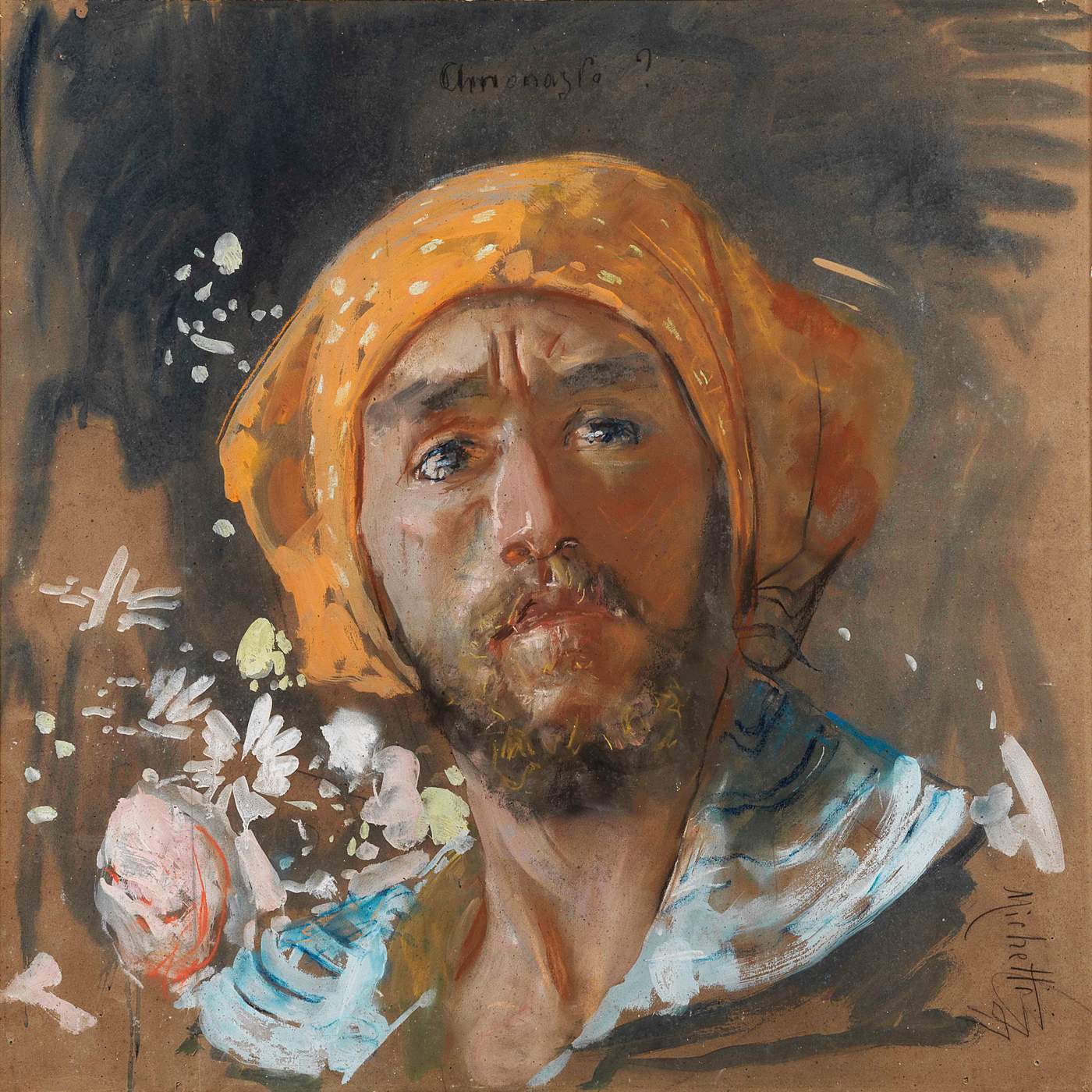
BorzoGallery is presenting three works by Constant at TEFAF for an interesting look at one of the founders of the CoBrA group (there are many works by artists who belonged to the group at the fair). The selection for TEFAF online, the gallery points out, is a prelude to a larger presentation at TEFAF 2022, when BorzoGallery will devote special attention to the artist ahead of the Constant 1 0 1 initiative. This project, initiated by Fondation Constant, includes a multidisciplinary program in collaboration with museums, educational institutions and artists, among others, and looks ahead 101 years after Constant’s birth to highlight his influence on contemporary art and that of future generations.
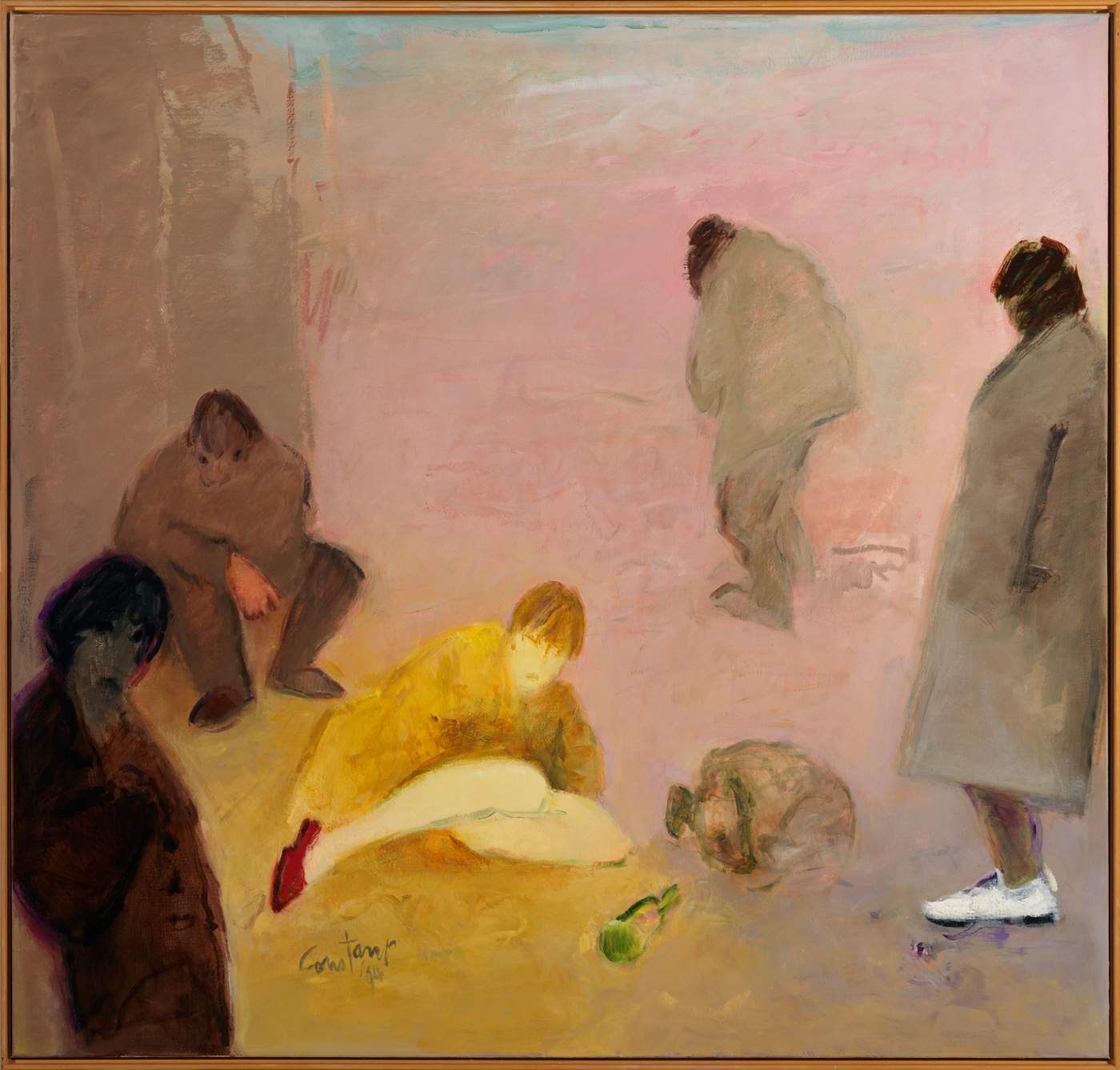
Berko Gallery presents three works by Eugène Verboeckhoven, the leading Belgian animal painter of the 19th century: portrayed here is one of King Leopold I of Belgium’s little dogs. For more than 40 years Berko has been collecting the works of Eugene Verboeckhoven, who since 1832 painted the favorite pets of King Leopold I and Queen Louise d’Orleans, then newly married. Most of these paintings are still preserved in the Royal Collections in Belgium and the Dynasty Museum in Brussels.

The painting presented by Canesso, formerly attributed to Titian, was owned by Caroline Murat’s sister when she was queen of Naples, after which she followed her to Frohsdorf Castle in Austria. In 1822 Charles Vane, III Marquis of Londonderry, purchased much of Caroline’s collection, in turn consigning thirteen pieces to Christie’s in London the following year; the work was among them, still attributed to Titian. After several passages through private collections, the work was purchased by a collector living in Vienna before World War II, after which it was returned to its previous owners in 1948. This family left it on loan to the Palace of the Legion of Honor in San Francisco between 1949 and 2011. Sold by their descendants in New York in 2012, it returned once again to Europe. The artist painted a beautiful Venetian woman, seen frontally and wearing a light petticoat that allows a glimpse of one of her breasts: it is inspired by Titian’s Flora from the Uffizi, though without motological connotations. The young woman is caught in an intimate moment, an idea further reinforced by the long blond hair loose over her shoulders. Add to this her languid gaze toward the young suitor who takes her wrist, and it becomes clear that this is a scene of amorous passion and future promise. That this woman, who carries all the sophistication of a seductress, can be identified as a courtesan, does not really alter the essential notion of the image, that of a romantic liaison. The young man, dressed in the fashion of the time, nevertheless has a certain decorum, as implied by the white feather in his red cap and the large pale blue bow holding his sword. The theatrical effect is accentuated by embroidery, gold jewelry, and deep, shimmering colors. Thanks to Luisa Vertova, the painting has recently rediscovered its true authorship, after having spent the 19th century and much of the 20th century with the names of the most illustrious Venetian painters, the same ones who initiated this kind of latent eroticism. In addition to the aforementioned Titian, the painting was in fact also attributed to Paris Bordon and Palma Vecchio. The Canesso Gallery also presents, worth seeing, a portrait of a lady by Lavinia Fontana and a Madonna in Adoration of the Child by the Master of San Miniato.

A work by one of the leading figures of Spanish Romanticism, Antonio María Esquivel y Suárez de Urbina, whose absolute protagonists are the eroticism and sensuality of the girl. The young woman is shown on the edge of the bed as she opens the curtain uncovering her room, in what appears to be an invitation to be part of that intimacy. It is likely that the painting presented by Caylus was paired with the Dancer in the Boudoir auctioned at Sotheby’s London on July 29, 2020, as the two works share themes and measurements. Moreover, thanks to an image from the photo library of the Fundación Universitaria Española, we know of the existence of another version of this painting of lower quality, although the measurements are not indicated.
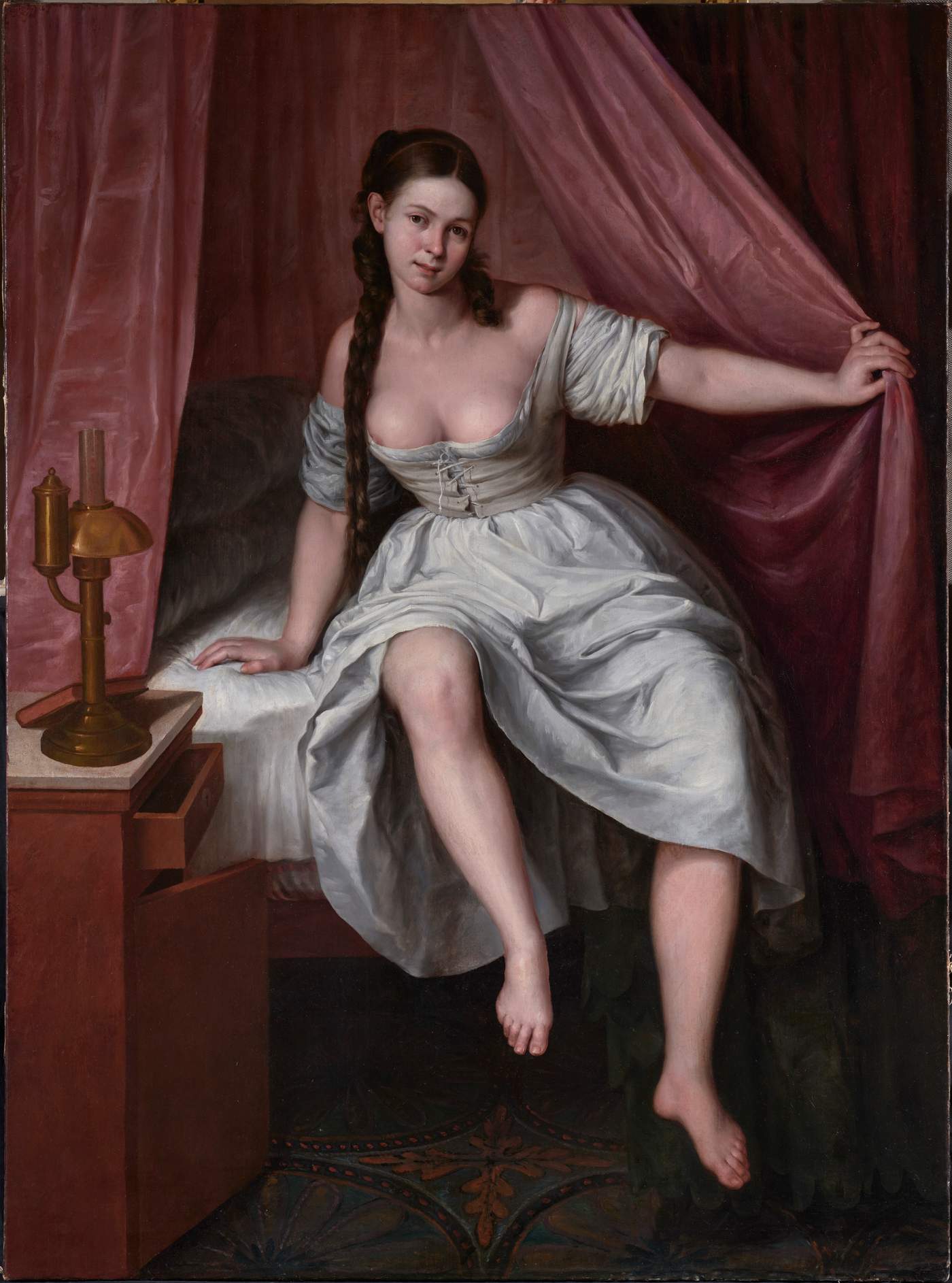
This is a decoration in the shape of a Nubian ibex head that was probably part of a cosmetic spoon or saucer in ancient times, and is made of Egyptian blue, a pigment that was produced by firing a compound of copper ore, silica sands, and limestone rocks. It is considered the first synthetic pigment. The Nubian ibex is a wild desert animal and is perfectly recognizable by its imposing horns rolled toward the back. It should be remembered that in objects like these the ibex horn is a symbol of renewal, rebirth, regeneration of life. There are many toiletry objects that use the ibex as iconography or form. These objects served to rejuvenate the person, to make him or her more beautiful-hence its symbolism. Often the ladies of the court were buried with their usual small jewelry that was moved at the time of the funeral so that it could accompany their masters in their afterlife.
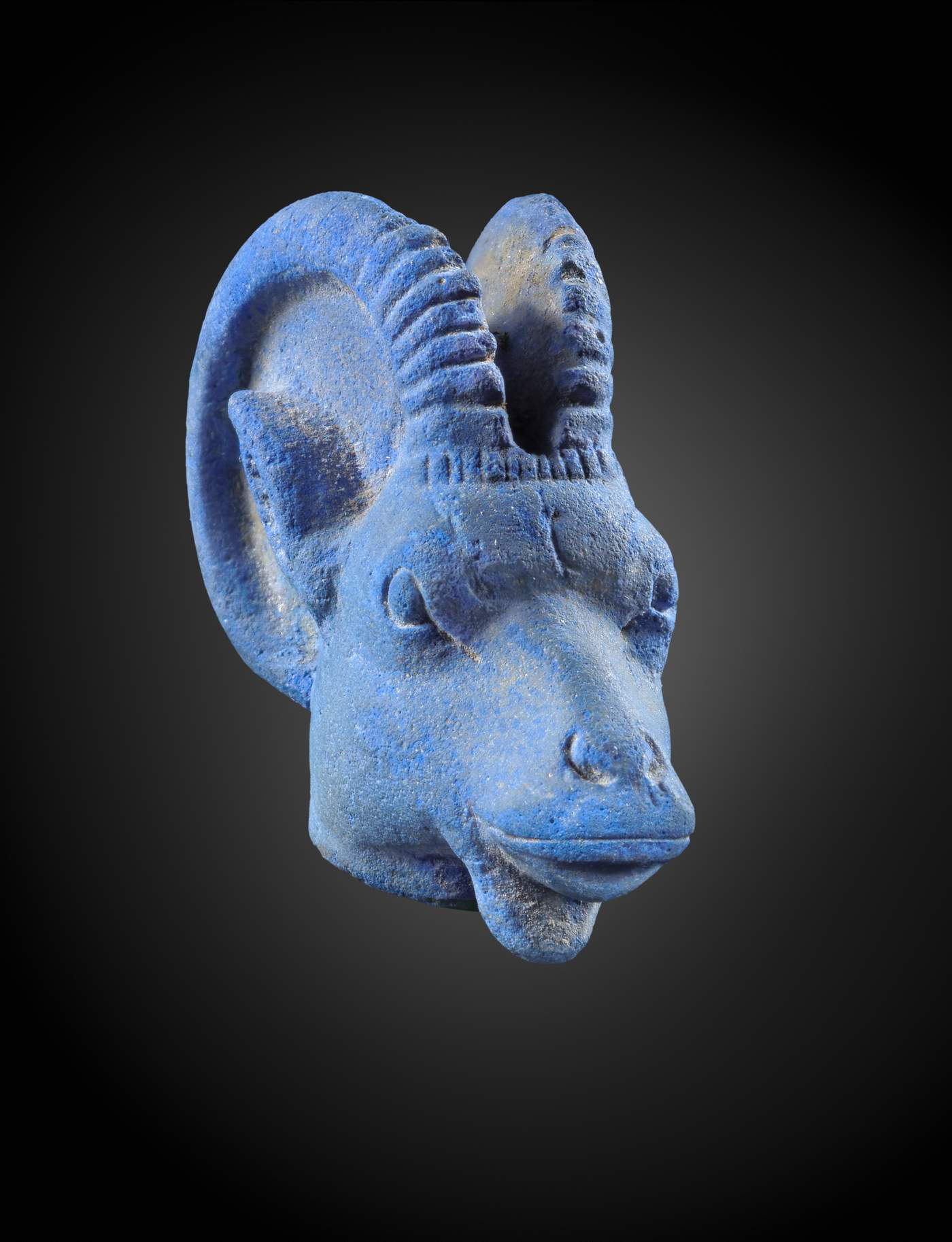
This painting depicts a well-known passage from the Book of Genesis about how Jacob, on his way to Haran, had fallen asleep dreaming of a ladder leading to Heaven, with angels ascending and descending. At the top of the ladder, Jacob had a vision of God promising him that the land on which he lay would one day become that of his people, the Israelites. This canvas, which has re-emerged on the market, was previously published in the Desubleo monograph, but with a poor black-and-white photograph, and listed as preserved at unknown location. The absence of a direct study has led scholars to underestimate its quality. Scholar Lucia Peruzzi was the first to publish this painting in 1986, dating it to about 1641. There is a second version in the United States, slightly larger and of the same subject, in the Barbara Piasecka Johnson collection in Princeton. The composition is similar but there are some substantial variations: the pose of one of the angels in the background, Jacob’s staff, and the type and placement of the brown and white striped fabric on the right, below Jacob’s head. In addition, the landscape on the left here lacks the outline of the mountain, the scene on the right is more narrowly organized, and the gourd is placed on the lower right. The Johnson version especially lacks the drapery covering the ground and part of the young man’s right legs, here painted in an extraordinary, vibrant reddish-brown. These fundamental variations indicate an autograph version of the subject, reflecting a typical Desubleo practice. Jacob’s Dream should be dated to Desubleo’s Parma period, that is, the last decade of his life.
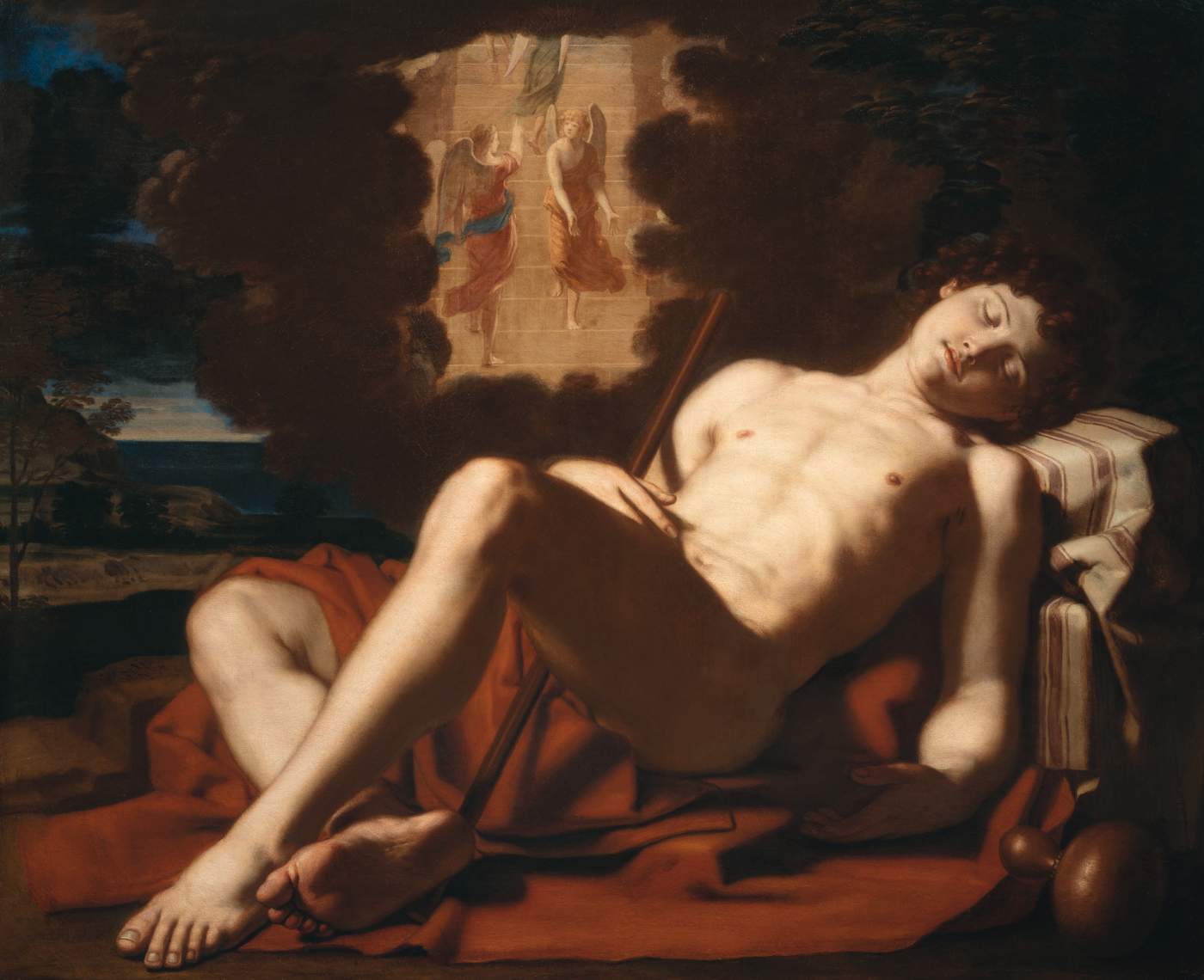
The Scarsellino painting presented by Hazlitt shows a scene described in all four Gospels: Christ, having descended from the Mount of Olives, enters the city of Jerusalem on a donkey, acclaimed by his followers and disciples. The event marks the beginning of the Passion in the Christian tradition and the beginning of the Easter liturgical celebrations. In the painting, Christ, dressed in red, raises his blessing right hand as the crowd breaks palm branches and lays their cloaks before him. The painting’s rapid brushstrokes and vivid colors of reds, oranges, and blues clearly reflect Scarsellino’s Venetian training, helping to date this work to the time of his return from Venice to Ferrara in the late 16th century. The facial type of Christ can be compared to the painting with Christ and the Virgin with St. Francis, now in the Brera Pinacoteca, dating from the early 1890s, and showing the rich tonality of Scarsellino’s early work. A painting ofChrist’s Entry into Jerusalem by Scarsellino was in the possession of the brother-architect Giuseppe Merenda (1687-1767), in his palace in Forli. No other works on the same subject are known, so who knows whether the painting in the Merenda collection is the work presented at TEFAF.

This panel was almost certainly made as part of a predella for a large polyptych. It seems to match perfectly in size, style, and decoration with a Saint James the Greater (sold by Finarte in Milan in 1967), also attributed to Matteo di Pacino and dated to the early 1470s. Already known as Master of the Rinuccini Chapel, Luciano Bellosi identified the artist as Matteo di Pacino in 1973, based on comparisons with Pacino’s only signed and dated work, the Stroganoff Polyptych. Other paintings by this master are at the Metropolitan Museum of Art in New York, the Lindenau-Museum in Altenburg, and the Galleria dell’Accademia in Florence. This Vir dolorum uses the traditional iconography of the wounded and emaciated Christ surrounded by the Instruments of the Passion, but instead of showing the Savior’s painful suffering, Pacino’s Christ seems calm, as if asleep, despite the blood dripping from his side wound. In this way, Pacino offers the viewer a sober, powerful and contemplative image in a way similar to his more complex later altarpiece of Christ Crucified at the Metropolitan Museum in New York. In both works, Christ’s shaggy beard and red locks frame a prostrate face with closed eyes.
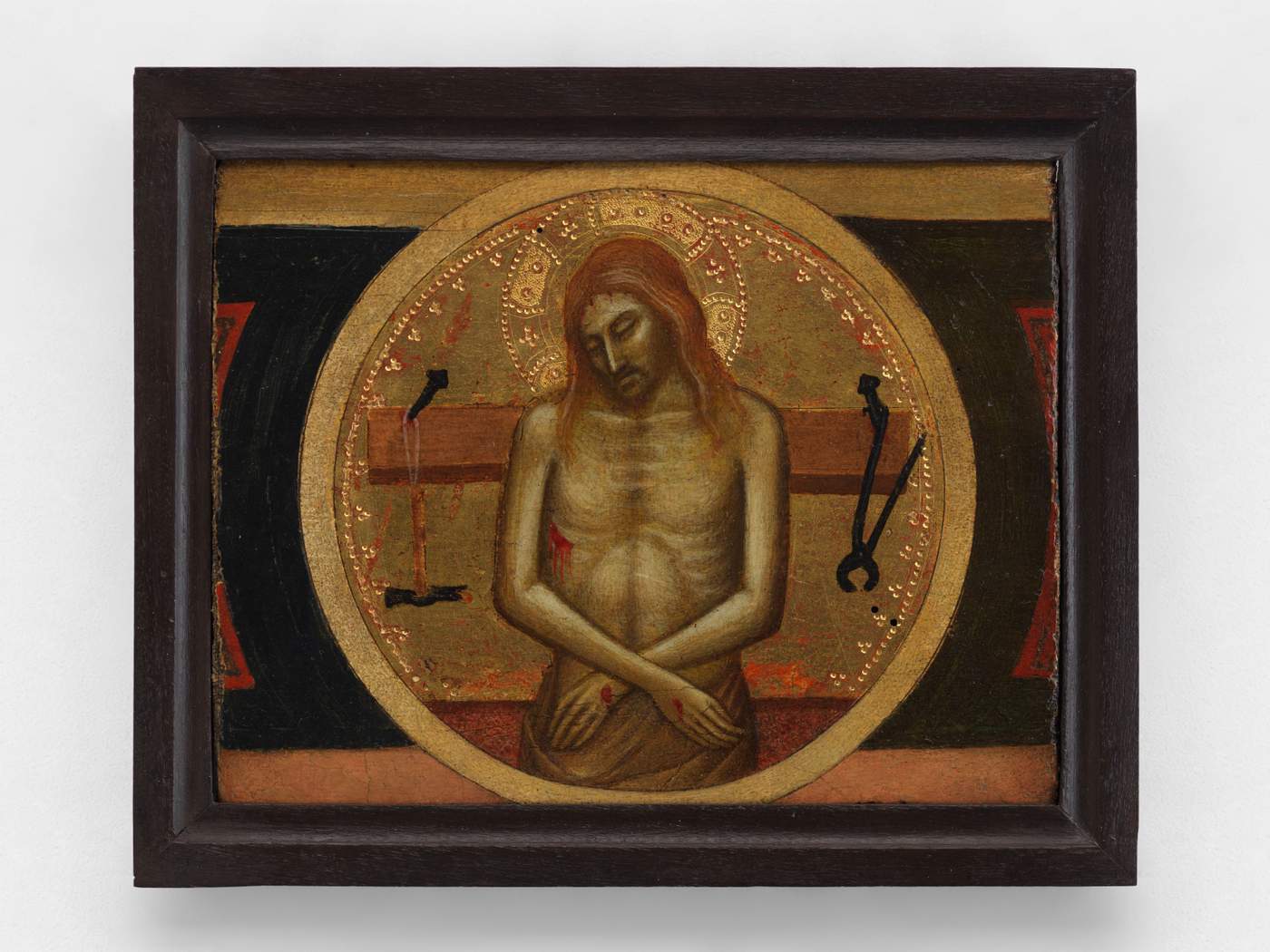
This tondo, depicting Christ among the Doctors, is a rare example of a Baroque “portable fresco.” It was painted by the great Neapolitan painter Luca Giordano in Florence for Andrea del Rosso around 1685, and is documented in the family collection as early as 1689, along with three other similar tondi (two of which are now lost, while the one depicting Christ and the Samaritan woman is currently in a private collection). Giordano’s use of this unusual technique finds few precedents in Florence, and challenges the rigid distinctions between categories that have always governed art history. Painting, artwork, performance art: all converge in this work. Mural painting, by definition immobile and tied to the architectural context for which it was conceived, becomes for Giordano a technical exercise of skill and speed of execution carried out for (and perhaps in front of) a prestigious patron: a true “performance” aimed at displaying the artist’s unparalleled virtuosity and inventiveness. Indeed, fresco painting requires more speed and confidence than oil painting on canvas or panel. While the latter allows for endless rethinking and changes because of the slow drying of the support, fresco painting requires the painter to mix pigments with the lime plaster while it is still wet resulting in a very rapid painterly exercise. The painting in question was first published in 1972 but remained unknown until recently, and because of its relevance to the artist’s oeuvre it was recently published and exhibited at the seminal monographic exhibition devoted to Luca Giordano recently held in Paris: Luca Giordano (1634-1705 ). Le triomphe de la peinture napolitaine (Petit Palais, November 14, 2019 - February 23, 2020).

The attribution of this work to Pietro Paolini bears the signature of Nikita de Vernejoul, who also considers this canvas the first of two versions of the same subject. The same scholar also identified the painting’s model as Francesco Di Poggio, a member of a noble Lucchese family. He was a famous poet and writer, praised in two sonnets by Elisabetta Coreglia. Born in 1594, he was canon of St. Martin’s Cathedral from 1628, prothonotary apostolic, and was, in addition to being a writer, a musician, a member of the Accademia degli Accesi and the Accademia degli Oscuri. His first major opera, La Psiche, a musical drama set to music by Tommaso Breni, was performed in Lucca in 1645 at the Palazzo De’ Borghi. It was promoted by the Accademia degli Accesi as part of the carnival festivities and was published by that Academy in 1654. The theme of portraiture in a literary cabinet dates back to the 16th century, especially in Venice, where connoisseurs were represented with books and sculptures, reinforcing their prestige, as in Andrea Odoni ’s Portrait of Andrea Odoni by The oil-lamp lighting adapted in Paolini’s portrait is highly original: the model of artificial lighting introduced by Honthorst in Rome in the genre scenes of the 1615s, reinterpreted by Paolini, gives the subject poetry and mystery. The character’s environment, reduced to its essentials, takes as its model Valentin de Boulogne, particularly the Portrait of a Prelate (France, private collection), whose power is concentrated in the eyes and hands. For these talking portraits, that is, charged with conveying a message, Paolini invented a type of erudite Caravaggesque portraiture that can convey an idea, a conviction, sometimes a deep anxiety and a sense of disorder, the power of which can shake the viewer. This portrait belongs to Paolini’s maturity, when the artist is at the height of his powers and when his mastery of chiaroscuro is perfect. Most of his known portraits were painted over a period of about ten years. The existence of a second version of this painting (Lucca Mazzarosa collection) with some variations, clearly of inferior quality, should affirm the importance of the character depicted.

This is an exceptionally well-preserved Hellenistic Greek gold laurel wreath from about 300 BC. This object consists of a cylindrical stem decorated with gold foil wrapped around a copper alloy core: fine spear-shaped leaves with impressed veins radiate outward from a central cup-shaped floral ornament. This crown reproduces in gold the laurel wreaths awarded as prizes in athletic competitions. Crowns of natural leaves, or in precious metals imitating nature, were awarded as prizes or worn in symposia and processions.

Stuart Lochhead presents a painted sculpture based on a mythological subject, a Shield that sits ideally at the center of the debate over the coloring of ancient marbles, while at the same time encapsulating the essence of Symbolist aesthetics. The original model for this Medusa was made in Böcklin’s studio in Hottingen, near Zurich, around 1885: it was sent to an exhibition of polychrome sculpture at the Nationalgalerie in Berlin that same year, but was broken during the return trip to Switzerland. Confident of the model’s strength, the artist decided to make other versions of this successful model, sometimes in plaster, sometimes in papier-mâché, or even mixing the two, as in the case of the present work. Böcklin’s work echoes the frontal composition of the ancient Rondanini marble, which was purchased in Rome in the 19th century by King Ludwig I of Bavaria and later exhibited in Munich, where it can still be seen today. This ancient marble was originally designed as a Gorgoneion, a protective amulet often worn by Athena and Zeus on the breastplate, whose apotropaic function originated in the Medusa myth. But there are other models as well: Böcklin, who often stayed in Italy, could also admire certain works preserved in Florence, such as Caravaggio’s celebrated Shield with the Head of Medusa in the Uffizi. His version of Medusa thus echoes an ancient sculptural tradition first reinterpreted in the Renaissance and Baroque. However, rather than focusing on a highly stylized or grotesque rendering of the subject, Böcklin’s Medusa is very human.
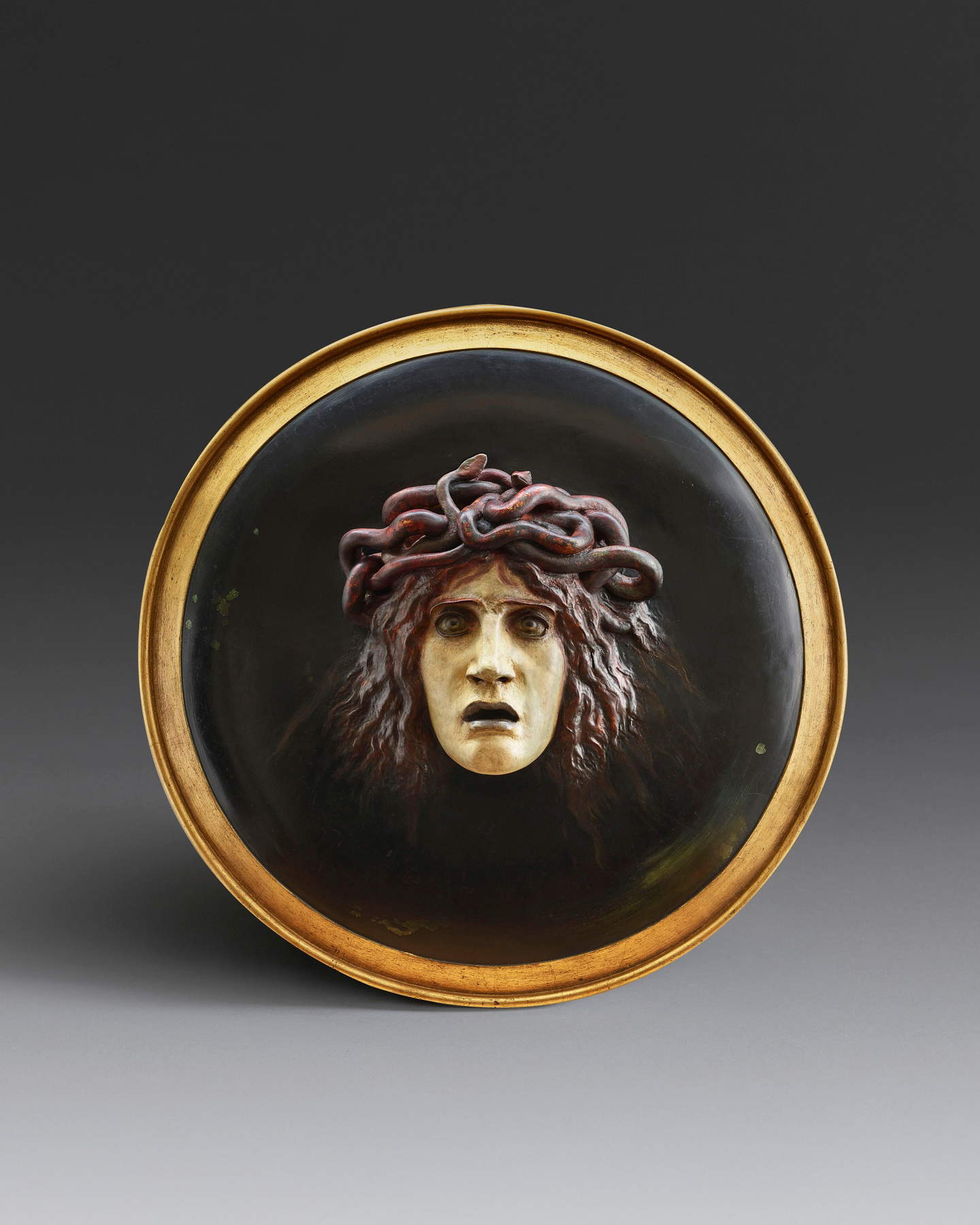
An alabaster sculptural group depicting the Crucifixion of Christ between two thieves, with the Virgin and St. John mourning at the foot of the Cross: probably intended for private devotion. The vividness of the narrative in the work is also enriched by the presence of an extraordinary predella carved into the base, in which some moments of the Passion are depicted: the Ascent to Calvary with the fallen Christ, Veronica wiping her face and Simon of Cyrene carrying the cross, against the background of a striking landscape, whose architectural details allude to the city of Jerusalem. As the inscription under the extraordinary predella recounts, “Petrus Orlando inventore Del(ineavit et) Fecit Drepani,” both the execution and the invention of the composition of this Calvary are by the sculptor Pietro Orlando, active in the city of Trapani in the second half of the 17th century, and to whom sources refer as a “renowned sculptor” in wood. Numerous other works mentioned in the biographies are no longer traceable or attributable to Orlando’s hand. The cultural context in which this work should be placed is characterized by a flourishing activity in southern Italy, between Sicily and Naples, specializing in scenes crowded with small figures carved in ivory, marble, alabaster, stone or coral.

Along with a similarly sized replica in the Palazzo dei Consoli in Gubbio, this painting was first mentioned in 1943 by Roberto Longhi in an update note to Battistello’s catalog; more precisely, it is identified with the Holy Family with Little Saint John that was in the Angelo Cecconi collection in Florence at the time. The Holy Family in question would appear to be the original version, and is part of a nucleus of small-format compositions that scholars date to around the end of the second or third decade of the 17th century. Among these is one, the signedAnnunciation, in the Wadsworth Atheneum in Hartford, also from the Florence antiquarian market, of remarkable similarity in arrangement. Dating the Holy Family to the same time frame, which includes the period of Caracciolo’s artistic maturity, is further suggested by the glazed plasticity of the figures.
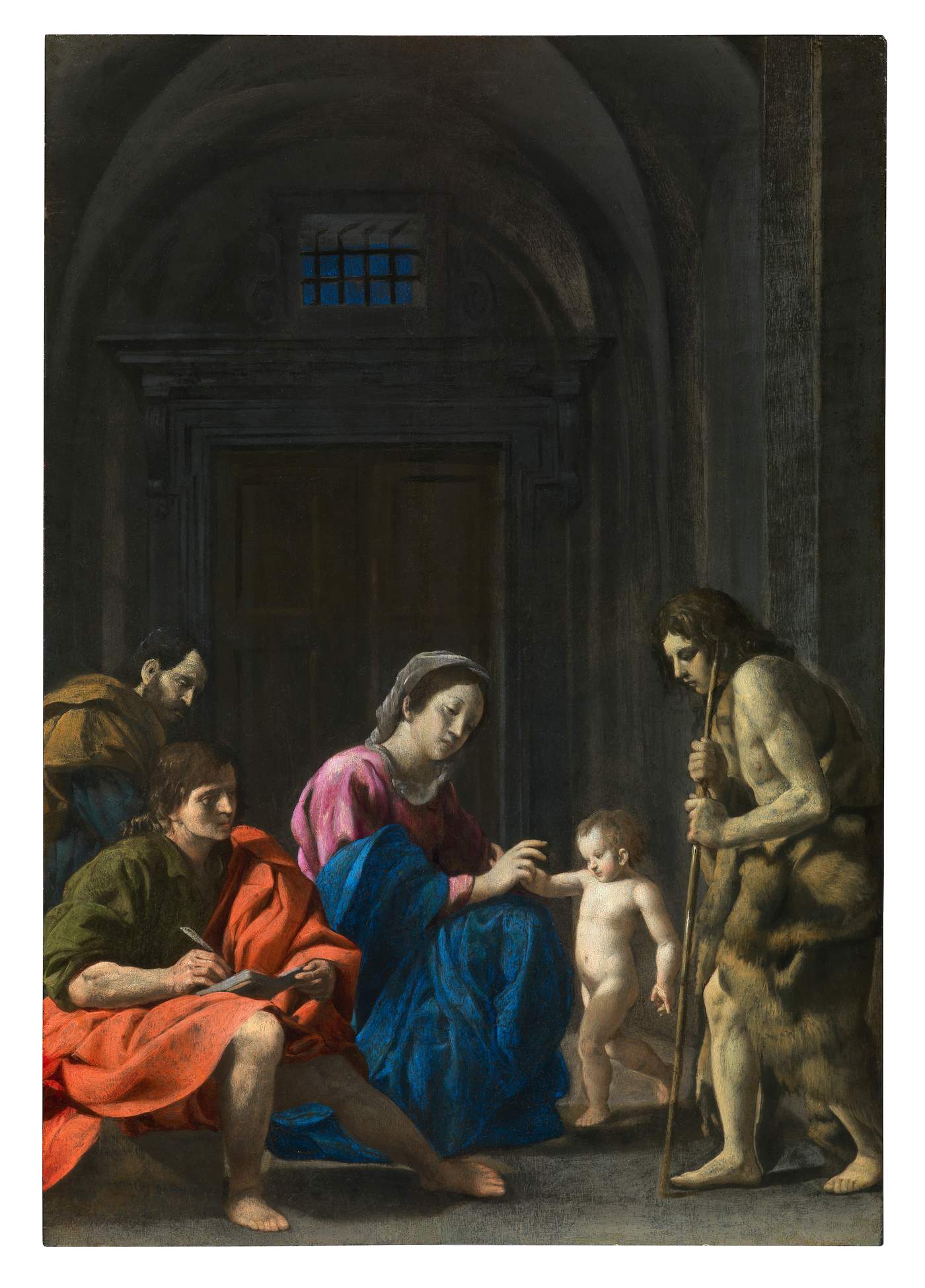
Long known to scholars, this complex terracotta group was published in 1900 by Stanislao Fraschetti, when it was owned by the princely Massimo family. Illustrated in the first monograph on Bernini as a work of the sculptor’s school, it was later attributed to Cametti. Scholar Andrea Bacchi, who signed the work’s file, considers there are numerous clues that suggest an attribution to Bernardino Cametti, who was born in Rome around 1669 to a family of Piedmontese origin. He became one of the greatest sculptors of early 18th-century Rome along with Camillo Rusconi, Angelo de Rossi and the Frenchmen Pierre Etienne Monnot, Jean Baptiste Théodon and Pierre Legros. A pupil of Lorenzo Ottoni, Cametti executed his first public work, the large marble relief of the Canonization of St. Ignatius, between 1695 and 1698 as part of the most important sculptural worksite in late 17th-century Rome, the decoration of the chapel dedicated to the Spanish saint in the Gesù church. Thereafter the sculptor was constantly engaged not only in churches in Rome but also in Orvieto, Bologna, Turin, and Madrid. The work in question was probably not a model for a larger work. In fact, the extraordinary finish combined with the vividness of every detail (from the straw on which the Child lies to the vegetation on the architectural features and the Virgin’s foot in the foreground) suggest that the small group was intended for a prestigious collection. After the careful conservation work conducted in the summer of 2009 with the removal of the brown repainting, the terracotta regained the authentically velvety surface appearance, making it possible to better read its style (even after cleaning, it remains impossible to decipher an inscription, perhaps a name, engraved in the clay before firing and placed on the base in front of the Saint Joseph).
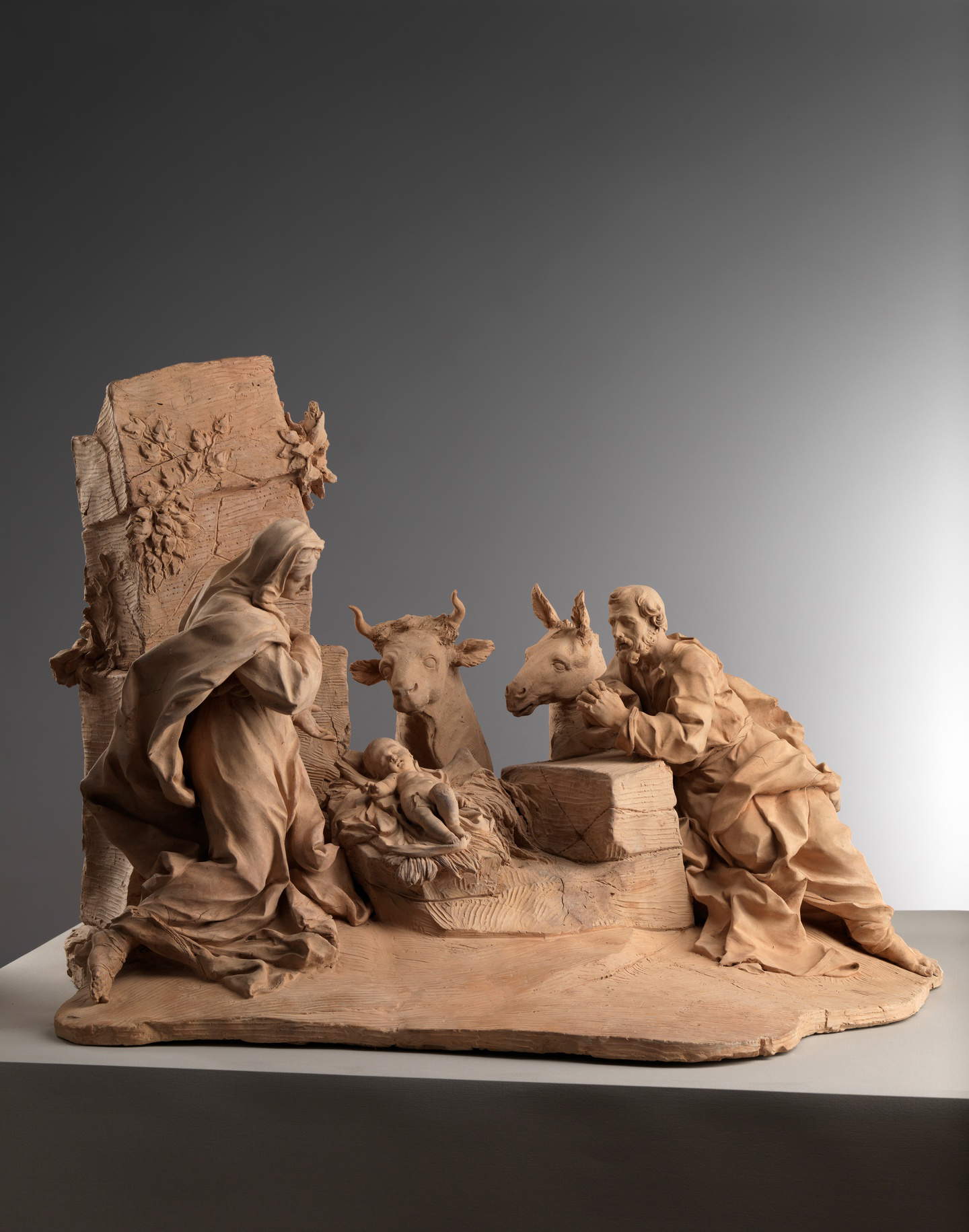
Alberto Altoviti’s portrait of Marquis Luigi presents the subject in the guise of a figure from the classical tradition, a convention embraced by painters of the Baroque era. The jug and cup from the subject led to identification with two mythological protagonists of great beauty: Ila, the companion of Hercules abducted by a river nymph on his way to fetch water, and Ganymede, admired and then abducted by Jupiter to become his cupbearer. Also at TEFAF, Galerie Perrin is moreover exhibiting an alleged portrait of the marquis in the guise of Adonis, also by Volterrano. Altoviti’s elegant pose and the suggestive arrangement of his hands (with one he holds the pitcher and cup and with the other the figure secures the sumptuous blue drapery at his hip) evoke an informal and decidedly sensual atmosphere. At the same time, her mane of red-brown curls, her adolescent physique, and the curious and inviting gaze with which she crosses that of the observer suggest at once the innocence of youth and also a certain femininity. Thus, the model embodies the seductive ambiguities of androgyny at the heart of the Platonic ideal of male beauty, a theme that captured the imagination of artists and patrons of both the Renaissance and Baroque eras, inspiring some of the most sensuous images of the early modern age.

Gregorio di Cecco was the adopted son and collaborator of Taddeo di Bartolo, a central figure in the Sienese art scene between the 14th and 15th centuries. Remarkable is his sophisticated and virtuosic rendering of details and use of a variety of techniques (sgraffito, punctuation, translucent lacquer), which also emerges from this well-known panel with Mystic Marriage of St. Catherine with Saints, Cherubs and Seraphim. Details that make Gregorio di Cecco a figure of great interest in early 15th-century Siena, when the great artists of the younger generation such as Sassetta were having the deep-rooted language of the 14th century developed into a more modern idiom. This work went to auction at Sotheby’s in 2018. The attribution to Gregory, and particularly to the early phase of his career, is due to Gaudenz Freuler.

Warning: the translation into English of the original Italian article was created using automatic tools. We undertake to review all articles, but we do not guarantee the total absence of inaccuracies in the translation due to the program. You can find the original by clicking on the ITA button. If you find any mistake,please contact us.